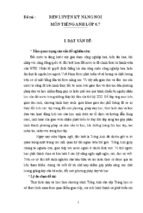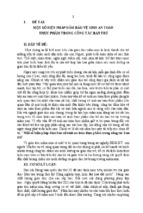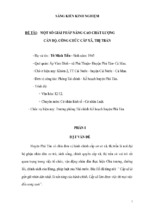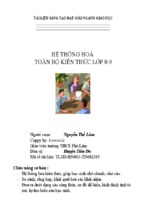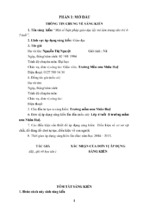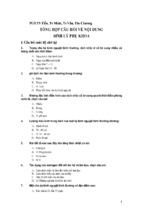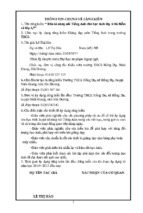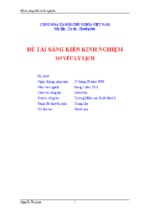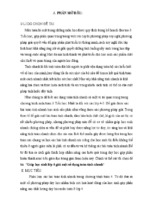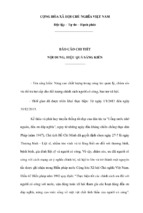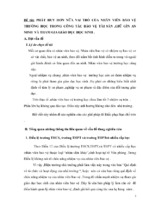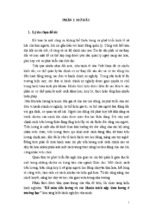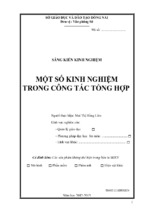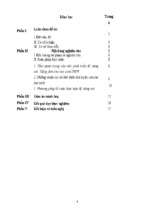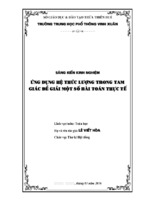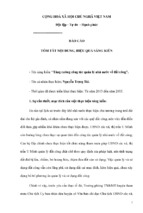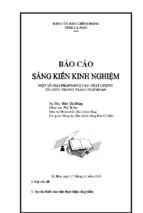THAI NGUYEN UNIVERSITY
SCHOOL OF FOREIGN LANGUAGES
BUI THI THANH VIEN
AN INVESTIGATION OF LISTENING STRATEGIES
FOR THE 10TH GRADE STUDENTS AT BINH LIEU HIGH SCHOOL
(Nghiên cứu về chiến lược nghe cho học sinh lớp 10
tại trường THPT Bình Liêu )
M.A. THESIS
(APPLICATION ORIENTATION)
Field: English Linguistics
Code: 8220201
Supervisor: Cao Duy Trinh (PhD)
THAI NGUYEN – 2019
DECLARATION
I certify my authorship of the study report entitled
“An investigation of listening strategies for the 10th grade students at Binh Lieu high
school”
The topic is a product that I have tried to study in the process of studying at Thai
Nguyen University as well as teaching at Binh Lieu high school. During the writing
process, there are references to some clearly-derived documents, under the guidance of
Cao Duy Trinh (PhD). I assure you if there is any problem, please accept my
responsibility
Quang Ninh, September 20th 2019
Trainee
Bui Thi Thanh Vien
This study was approved by:
Cao Duy Trinh (PhD)
i
ACKNOWLEDGEMENTS
I am deeply indebted to a number of people for helping me to make this M.A
thesis possible. First and foremost, my deepest gratitude goes to Cao Duy Trinh (PhD),
my supervisor, who supported and encouraged me generously throughout this study.
Without his excellent academic guidance and support, my thesis would not have been
completed.
I would like to sincerely thank the anonymous participants who contributed
data to this study. Without their outstanding cooperation, this thesis would have never
been done .
I would like to thank my family, especially my parents and my husband for
their constant source of love, support and encouragement in times of difficulty and
frustration.
Finally, I would like to thank my readers for their interests and comments on
this thesis.
While I am deeply indebted to all these people for their help to the completion
of this thesis, I myself remain responsible for any inadequacies that are found in this
work.
Bui Thi Thanh Vien
ii
ABSTRACT
This paper studies an investigation of listening strategies for the 10th grade
students at Binh Lieu high school. The study has the population of total 69 students of
the 10th grade of Binh Lieu high school at Quang Ninh province. These 69 students
come from three classes of the 10th grade. Sampling of a study is defined by qualitative
research and quantitative research.
Through this research, many aspects of listening have been clarified, such as
definition, types of listening, difficulties, importance of listening, how to improve
listening skill, listening strategies, and role of teachers in teaching listening skill.
The application of listening strategies in learning listening skill is very
important. Indirect listening strategy is considered as an effective strategy in
improving efficiency of listening compared to direct listening strategy. Its efficiency
and effectivenes is shown in the result of survey of 10th grade students at Binh Lieu
high school. In the survey to give solution for improving listening skill, a larger
number of students also give answers of listening learning skills related to indirect
strategies: learning listening in group, controling emotions, feelings and attitudes, and
plan to learn listening strategically.
iii
TABLE OF CONTENTS
Chapter 1: Introduction
1.1. Rationale ...............................................................................................................1
1.2. Aims of the study..................................................................................................1
1.3. Research questions ……………………………………………………………1
1.4. Scope of the study ................................................................................................1
1.5. Significance of the research…………………………………………………….2
1.6. Structure of the research………………………………………………………..2
Chapter 2: Literature review
2.1. Listening definition ..............................................................................................3
2.2. Type of listening ..................................................................................................8
2.3. The difference between hearing and listening………………………………...10
2.4. Listening skill…………………………………………………………………13
2.5. The importance of listening skill in daily life, work environment and language
learning……………………………………………………………………………….14
2.6. Barriers and difficulties in listening and learning listening…………………..17
2.7. The improvement of listening skill…………………………………………..24
2.8. The role of teacher in teaching listening skill………………………………..27
2.9. Type of listening strategies ……………………………………………………30
2.9.1. Direct listening strategies………………………………………………31
2.9.1.1.Cognitive strategies........................................................................31
2.9.1.2. Memory strategies.........................................................................32
2.9.1.3. Compensation strategies ...............................................................33
2.9.2. Indirect listening strategies……………………………………………..33
2.9.2.1. Metacognitive strategies ...............................................................33
2.9.2.2. Affective strategies .......................................................................34
2.9.2.3. Social Strategies ............................................................................34
2.10. The reality of learning English at high schools in Vietnam today…………..35
2.11. Previous Studies ...............................................................................................36
Chapter 3: Research methodology
iv
3.1. Introduction ......................................................Error! Bookmark not defined.8
3.2. Research design ...............................................Error! Bookmark not defined.8
3.3. Research site ………………………………………………………………….39
3.4. Sample and sampling procedures .......................................................................39
3.5. Data collection instrument……………………………………………………40
3.6. Data collection procedures ……………………………………………………41
3.7. Data analytical method……………………………………………………….41
3.8. Reliability and validily ………………………………………………………42
Chapter 4: Findings and Discussion.
4.1.Introduction ………………………………………………………………………43
4.2.Result and discussion …………………………………………………………….43
Chapter 5: Conclusions and recommendations……………………………………52
References …………………………………………………………………………54
Appendix A……………………………………………………………………………
Appendix B……………………………………………………………………………
v
CHAPTER 1: INTRODUCTION
1.1. Rationale
Listening is a process that allows the listeners to understand a message, help
them engage in dialogue and succeed in communication. Without listening skills,
people engaged in communication activities will not receive the message, and
therefore, they cannot respond quickly and efficiently (Mberia, 2011). Many
researchers agree that in language learning, listening plays an important role in the
reception of a language.
Recently, listening skill has been gaining much attention among researchers in
teaching and learning foreign languages in general and learning English as a Foreign
Language (EFL) in particular. Many scholars believe that the most important step to
start learning English is to try to hear the language. In addition, listening skill brings
the students the opportunity to feel the language and improve the overall ability to use
English (Yıldırım and Yıldırım, 2016).
Rost (1994) also emphasized that listening could be seen as a necessary skill in
the process of training a foreign language learner and even could be considered as a
tool to predict the success of English learners. As such, listening skill plays an
important role in learning English. Therefore, the topic “An investigation of listening
strategies for the 10th grade students at Binh Lieu high school in Quang Ninh
province” is chosen for research.
1.2. Aims of the study
The study aims mainly to explore listening strategies which the 10th grade
students at Binh Lieu high school in their English learning process, particularly:
-
To explore the direct listening and indirect listening strategies of the 10th
grade students at Binh Lieu high school.
-
To explore their effect differences between using direct listening strategy and
indirect listening strategy in learning English.
-
To provide solutions for improvement of the students‟ listening skill.
1.3. Research questions
1. What listening strategies do the 10th grade students at Binh Lieu high school
use?
1
2. Are there any differences of tests‟ results between direct listening strategy and
indirect listening strategy used by the 10th grade students of Binh Lieu high
school?
3. What are solutions for the improvements of the students‟ listening skill?
1.4. Scope of the study
*Geographic location
The research is going to be conducted in Binh Lieu high school in Quang Ninh
province. This is done to obtain an objective result for the applied research.
*Demographic objects
The 10th grade student at Binh Lieu high school is included in demographic
profile. 100 students of the 10th grade of Binh Lieu high school take part in the survey.
In a wide range of respondents, there are some mistakes that can surely happen when
doing survey with the type of error such as the respondents not focusing on the
questions. Thus, they may decide the answers by chance without thinking and share
their true idea, for instance their answers are just all “agree” or “disagree”. In addition,
the respondents had no time to answer the questionnaire, and then they may give
incorrect answers.
*Temporal aims
The time frame for conducting this research and examining the results is
estimated to be a half of year or longer depending on whether there is a constraint of
funds and manpower. The research is written in 2018.
1.5. Significance of the research.
In the aspect of the scope of the research, it is important in finding out listening
strategies. And these strategies are understood through the application of investigation
of the 10th grade student at Binh Lieu high school. From that, it is useful to find out the
best listening in learning English.
1.6. Structure of the research
In chapter 1, it is introduction. The study presents general parts including
background to the study; problem statement; review of related literatures; purposes of
2
the study; research question; scope of the study; methods; significance and structure of
the study.
In chapter 2, the study presents literature review including concepts and
previous studies relating to this topic.
In chapter 3, it is research methodology. The study presents research questions,
research participants, research procedures, data collection instruments and data
collection and analysis process.
In chapter 4, the study shows findings and discussion after analyzing data
In chapter 5, the study presents conclusions and recommendations. There are
three parts in conclusions consisting of conclusion of the thesis, limitation of the thesis
and suggestions for further researches.
3
CHAPTER 2: LITERATURE REVIEW
Learning English is a long time process requiring perseverance and patience.
The listening subject is one of four difficult skills for learners. In order to have a good
listening, listener has a must of a wake head. During listening process, unrelated things
need to be removed from the brain. In fact, many students have to face with English
listening as well as other foreign languages. The literature review of this research is
going to state some things about listening skill, factors that affecting listening and
kinds of listening strategies. Some previous studies are also described in this literature
so that we can see previous researchers‟ views on listening.
2.1. Listening definition
The word “listening” has been defined by many authors all over the world.
Babita (2013) gave a definition of listening as a language modality. It is one of four
language skills including listening, speaking, reading and writing. Listening must need
to have an active involvement of a person. In listening, there is the relationship of
sender, receiver and message. Listening is a psychological process of receiving,
attending to constructing meaning from and responding to spoken and non-verbal
messages. In a similar aspect, Barker (1971) presented listening was the selective
process of attending to, hearing, understanding and remembering aural symbols. So,
listening is quite complicated and requires high concentration. If not, key words or key
messages will be lost. The role of listening is promoted so much. Having a deep view
of listening, Tucker (1925) brought a profound definition of listening. Particularly, it is
“an analysis of impressions resulting from concentration where an effort of will is
required”. As so, both Baker (1971) and Tucker (1925) had same thought that listening
required a highly concentrated brain. In the case that a person has responsibility to
listen a text and write the main content of the text; however, during the process of
listening, he or she lets his or her brain focus on the other issue. Consequently, the
result of listening is not good. In other words, he or she does not understand what the
key words of the text are. He or she failed in listening. According to the view of
Ahmadi (2016), listening consisted of “the auditory discrimination, aural grammar,
choosing necessary information, remembering it, and connecting it to the process
between sound and form of meaning”. In general, listening is a skill that needs the
4
choice of key information, need to remember it. The below is listening definitions of
many authors who wrote very long time ago.
As time passes, listening has been defined in different ways which has
depended on the areas of expertise of educators; these educators have done in social
sciences. Listening, at the beginning of 19th century was understood “in terms of
reliably recording acoustic signals in the brain” (Rost, 2002). The definition was
different in decades later when there was more information about human brain. It was
defined as “unconscious process controlled by hidden cultural schemata”. Coming to
40s of 19th century, due to the development of telecommunications, listening was
“successful transmission and recreation of messages”.
In the 1960s, listening
composed of listeners‟ own experiences to understand the intention of the speaker. In
the 1970s, “the cultural significance of speech behavior” was accepted. “Parallel
processing of input” is the definition of listening in decades of 80s and 90s. Listening
comprehension was defined as “an active and conscious process in which the listener
constructs meaning by using cues from contextual information and from existing
knowledge, while relying upon multiple strategic resources to fulfill the task
requirements” (O‟Malley, Chamot, and Kupper, 1989). The definition of Vandergrift
(1999) was more widen when listening was more complex and active. The complexity
was due to the discrimination of listener between sounds. Moreover, it was also
understood in vocabulary, grammatical structures, interpret stress and intonation
Figure 1: Listening definitions of authors
Author
Tucker
Year
Definition
1925
An analysis of the impressions resulting from concentration where
an effort of will is required
Rankin
1926
The ability to understand spoken language
Nichols
1948
The comprehension of expository materials presented orally in a
classroom situation
Barbe
&
1954
language in terms of past experiences and further course of action
Meyers
Brown
The process of reading to interpreting and relating the spoken
&
1955
The aural assimilation of spoken symbols in a face-to-face speaker
5
audience situation with both oral and visual cues present
Carlson
Barbara
1957
A definite usually voluntary effort to apprehend acoustically
Spearritt
1962
The active process involved in attaching meaning to sounds
Barker
1971
The selective process of attending to hearing, understanding and
remembering aural symbols
1972
Weaver
A process that takes place when a human organism receives data
orally. The selection and retention of aurally received data
1975
Kelly
A rather definite and deliberative ability to hear information to
analyze it, to recall it at a later time and to draw conclusions from it
Steil et al.
1983
Consists of four connected activities – sensing, interpreting,
evaluating and responding
Wolff et al.
1983
A unitary-receptive communication process of hearing and
selecting, assimilating and organizing and retaining and covertly
responding to aural and nonverbal stimuli.
Wovin
&
1988
aural stimuli.
Coakley
Brownell
The process of receiving, attending to and assigning meaning to
1994
An overt behavior that conceptualizes the teaching and training
process
ILA
1996
The process of receiving, contructing meaning from and responding
to spoken and/ or nonverbal messages
Cooper
1997
Listening competency means behavior that is appropriate and
effective. Appropriateness means that the content is undertsood and
effectiveness deals with achievement of interactive goals.
de Ruyter
2000
{ as perceived by customers} A set of interrelated activities,
including apparent attentiveness, nonverbal behavior, verbal
& Wetzels
bahaviors, perceived attitudes, memory and behavioral responses
Bostrom
2011
The acquisition, process and retention of information in the
interpersonal context.
* Definitions published prior to 1988 are drawn from Glenn (1989) and Wolvin and
Coakley (1988)
6
Listening is an important skill and is expressed by some key components.
Babita (2013) listed components of listening such as the discrimination among sounds,
the recognization of words and the understanding of meaning, the identification of
grammars, the identification of expressions and sets of utteranes that act to create
meaning, the connection between linguistic cues and non-linguistic and paralinguistic
cues. Moreover, listening still uses the background knowledge on the purpose of
predicting and confirming the meaning; for the final purpose, it is used to recall
important words and ideas. As a result, the participation of these components will
create a good ability in listening.
The process of listening is implemented through five steps. It includes
hearing, understanding, remembering, evaluating and responding (Babita, 2013).
Hearing is the process of sound waves awakening the subconscious of brain. It is not
to listent to hear, but it is to hear to listen. In order to have effective listening, it is
essentially neccesary and important to have a brain with a good hearing. You can hear
something, but you must analyse what you heard. It is called “understanding”. In other
words, when you perceive an information from sender, you are in charge of analyzing
the meaning of the information. The analysis is not only about sounds, but also about
words, sights, body…etc. So, so as to obtain successful communication, the listener
has to understand the intended meaning and the context assumed by the sender. In
listening process, “hearing” and “understanding” is not enough. You hear the content
of message, you also understand what the message is about; after that, you forget the
messeage content that sender want to transmit to you. As a result, you fail in listening.
A completed listening process must require the word “remembering”. Based on the
view of Ulum (2015), remembering means that a person has not only received and
clarifies a message but has also added it to the brain‟s stockpile. Remembering is
something saved in the memory after hearing and understaning. Remembering is
different from what was seen and heard. Referring to evaluating, not all listener would
like to join in this step, but active listeners are supposed to complete this step. By
experience and fact, active listeners will determine the apprearance or absence of bias
or prejuidice in a message. Evaluating must be carefully assessed after hearing and
understanding as well as remembering messages (Babita, 2013). An effective listening
7
is achieved only when evaluating does not begin too soon. It means that evaluating is
practiced when the incoming message ends. On the other hands, if without hearing,
understanding and remembering all contents of message, evaluating will be wrong.
Sometimes, the beginning and the middle of the message do not present all aspects. As
a result, we must follow the message from the beginning to the ending on the purpose
of getting effective listening. The final step in listening process is responding.
Responding is understood as the feedback that the receiver provides after the
completion of listening process. The feedback can be shown through verbal or
nonverbal. Feedback is the description of the succesful level of the transmission of
message to receivers.
Figure 2: Five steps of listening process.
2.2. Types of listening
Depending on the purposes and ways that listeners perceive and respond to the process
of listening. It can be divided into different types as below:
-Active listening: simply understanding that listeners are active in listening
process. In other sentences, active listening means listeners show their interests in
listening to what speakers are speaking. This type of listening is related to the
encouragement of continued speaking. It is continuous to speak as listeners want to
continuously listen.
8
- Appreciate listening: while listening to senders, listeners would like to find the
way to appreciate senders. The reason is that listener‟s needs and goals are satisfied
(Babita, 2013). Consequently, listener will be appreciated to praise sender. This type
of appreciate listening is suitable for good music, good presentation …etc.
- Biased listening: it is easy to be clear about biased listening that one person just
only hears what he or she wants to hear. He does not want to hear others. There are
much news in the text; however, listener will choose the message that is useful for him
or her. Naturally, biased listening is very evaluative.
- Attentive listening: it is opposite of biased listening. It means listener cares much
about message. Therefore, he or she will pay attention to what sender is talking. He or
she listens obviously and carefully.
- Casual listening: show listening attention not obviously. Sometimes, listener
cares much about the content of one message. Nevertheless, the attention is left when
he or she does not care. Actual attention may vary a lot.
- Comprehension listening: the purpose of this type of listening is to understand
the information of message that sender wants to transmit to. When hearing the text,
listener will seek the meaning of the text. It is not necessary for listener to be clear
about all information on the text, but listener must understand what main content is.
- Critical listening: this type of listening is more professional because the purpose
of listening is to evaluate. After hearing, understanding and remembering; listener will
give an evaluation about the message. The evaluation can be the agreement, approval,
criticism, or judgment (Skills you need, 2019).
- Deep listening: it is to seek to understand a person, understand about the
personality, characteristics and real meaning which are not spoken. In clearer
meaning, deep listening is not only to hear what sender said, but also to listen to the
whole person. Whole person here is to listen to the body, gesture, attitude, and action.
Listener can also see the person‟s bias, beliefs, values and preferences …etc
- Discriminative listening: this is the basic kind of listening. It is different
between different sounds. The meaning is that different sounds are identified. If you
cannot hear the differences, then you cannot make sense of the meaning that is
expressed by such differences. We learn to discriminate between sounds within our
9
own language early, and later are unable to discriminate between the phonemes of
other languages. This is one reason why a person from one country finds it difficult
difficult to speak another language perfetly, as they are unable distinguish the subtle
sounds that are required in that language. Likewise, a person who cannot hear the
subtleties of emotional variation in another person‟s voice will be less likely to be able
to discern the emotions the other person is experiencing (Purani, 2013)
- Empathetic listening: understanding the feelings of other peoples is what to be
called empathetic listening. This demonstrates empathy. This type requires excellent
discrimination and close attention to emotional signals. In the case that listener is
really empathetic; he or she will feel what other people are feeling.
- Evaluative listening: it is similar to critical listening. The purpose is to
evaluate, criticize, and judge on what other people said.
- Inactive listening: it is opposite of active listening. Listener will pretend to
listen to the message; but in fact, he or she would like to spend more time on thinking.
He or she can think about what the person said before, and does not care or listen to
what the person will say next. Or listener can think about the matter outside the
message that the person is talking.
- Partial listening: listener takes much time on listening to the person saying.
Nevertheless, some times, listener will listen in a drowsy way; or he or she does not
continue listening and thinking of the answer for the previous question. This type of
listening is often seen for learners who hear English listening. They struggle to think
about the first answer; and do not know the second question is floating away.
- Reflective listening: you have listened to a text, and then you reflect the
content of the text back to other persons
- Informational listening: when you listen to learn something, it is called
informational listening. Informational listening is held most of everyday, at most of
everywhere. It is easy to be recognized in education when students try to listen to learn
their lessons. It is also recognized at work
Generally, among various types of listening, five types of listening are considered as
the most important and main listening. They are discriminative listening,
comprehensive listening, informational listening, critical listening and empathetic
listening.
10
2.3. The difference between ―Hearing‖ and ―Listening‖
As mentioned above, there are many different opinions about listening. It is
also recognized that “listening” and “hearing” are two different categories. According
to Hasan (2000), "hearing" and "listening" are two distinct processes in which
"hearing" is a process by which listeners receive information, and this process takes
place one way at a time, unlike interpretation or interaction with the text. Simply
understanding, “hearing” is the information that it gets into the ear by accident, or
randomly. Hearers can perceive all messages or a part of messages. In contrast,
listening is the process of two-way interaction between the listener and the listening
text, and this interaction gives the listener an overall understanding of the text. With
wisdom and understanding, listener will make an effort to listen all information in the
text. This "hearing" and "listening" process is performed when the listener selects and
interprets the information received through the hearing organ and other visual cues (if
any) for the purpose of understanding the message of the speaker.
This view of listening comprehension is also consistent with the second
hypothesis of the language spoken by Richards (2002) and O'Malley & Chamot
(1999). This assumes that listening to spoken language is an activity and a complex
process in which the listener focuses on the chosen aspects of the listening. From the
sounds they hear, they find the meaning of the listening message, and relate to what
they hear to the knowledge they currently have. Additionally, Brette (1995) stated that
hearing is a decisive language skill. It plays an important role in the acquisition of
language. When comparing listening with other language skills, Morley (2001) also
points out that on average each of us listens "twice as much as we say, four times what
we read, and five times what the learner wrote ".
The researchers distinguished between Listening and Hearing. Listening is an
active process, including sound analysis, which is different from Hearing, which only
captures sounds passively. In the same way, Harmer (2001) stated that Listening is a
"receptive skill" when learners receive the main idea through what they hear. Listeners
receive the message of the speaker through accent, pronunciation, grammar, and words
that the speaker uses and understands the meaning of their message.
11
Richards and Schmidt (2002) describes listening as comprehension of speech in
the first or second language, and listening comprehension of a second language
involves both top-down and bottom-up processes. (Bottom-up). Brown (2006) also
shares this view and argues that the "top-down" process occurs when learners use
background knowledge and vocabulary available to capture the content of the
listening, while the bottom-up process is to use the context of the listening to predict
the meaning of the new word. According to Helgesen (2003), hearing is an active and
purposeful skill. During the listening process, the listener not only captures the content
they are listening to but also can listen to the information they have previously known
to understand the listening. In addition, Helgesen also said that when listening, the
listener is not just listening to the words, but also understand the implications behind
the words.
According to Kline (1996), in order to learn and teach listening effectively; it is
extremely important to be aware of the difference between listening and hearing. The
difference in the view of Kline was obviously described as the following: “hearing is
the reception of sound, listening is the attachment of meaning to the sound. Hearing is
passive, listening is active”. In the similar meaning, Rost (2002) presented hearing
different from listening that “hearing is a form of perception, but listening is an active
and intentional process”. It is clear that both hearing and listening are shown in the
involvement of perception. However, the level of perception is different. Listening is
involved with high degree of intention. Hearing is at lower degree. Hearing is formed
early. It is true for new born children. As soon as being born, children are able to hear
(Flowerdew and Miller, 2005). Right after getting out of the womb, children could be
able to hear the sounds around. However, their perception of sounds is very low. At
the starting time, children will hear, and then show their attention to listen. Speaking is
the second activity of children after listening. The next activity is reading, and then
writing is the final skill of children. This proves that listening is the first skill of
language (Lundsteen, 1979).
In recent time, Surbhi (2016) provided an easily knowledge of listening
definition that hearing is through ears, but listening is through the mind. As so, both
hearing and listening use ear for involvement, but they are different. In hearing, ears
will help you perceive sound waves and noise. It is the power of perceiving sounds. In
12
contrast, listening means you receive sound waves and clear about it by paying
attention to words and sentences of speaker.
Figure 3: The difference between hearing and listening
BASIC FOR
HEARING
LISTENING
COMPARISON
What is it ?
Hearing refers to one‟s ability to Listening is
something
done
perceive sounds, by receiving
consciously, that involve the analysis
Vibrations through ears.
and understanding of the sounds you
hear
An ability
A skill
Nature
Primary and continuous
Secondary and temporary
Act
Physiological
Psychological
Involves
Receipt of message through ears
Interpretation
Meaning
of
the
message
received by ears
Process
Passive bodily process
Active mental process
Occurs at
Subconscious level
Conscious level
Use of senses
Only one
More than one
Reason
We are neither aware nor we have We listen to acquire knowledge
Concentration
any control over the sounds we hear
and receive infotmation.
Not reqiured
Required
2.4. Listening skill
According to Rubin and Thomson (1994), listening skills are divided into two
categories based on the type of listening process: (i) basing on reciprocal hearing: this
process occurs when the listener is asked to participate in the interaction process and
to alternate between listening and speaking. Situations that require interactive listening
include live and telephone conversations. In these situations, listeners have the
opportunity to ask the speaker to speak more clearly, repeat or speak slowly; (ii) Nonreciprocal listening: This kind of hearing takes place when the listener participates in a
passive passage of a monologue, a speech or a conversation.
Successful listeners are those who can incorporate "inside the head" knowledge
that is, knowledge that is not coded directly in words - and that knowledge “outside
the head knowledge” to understand what they are listening, according to Nunan
(1991). Anderson and Lynch (1988) also distinguished these two processes by
13
opposing the process. The bottom-up process of the listener - like the "tape recorder" with the top down process - is "modeling" (model builder). Therefore, the use of both
types of knowledge is essential. The concept of the processes up and down in listening
comprehension is also discussed by Anderson (1983) and Rubin (1994).
According to them, the bottom up process involved initiating by identifying
sounds, distinguishing words and understanding grammatical structures, and finally
understanding the meaning of the message. This is a mechanical process and a
research focus of some teaching methods (Brown, 2006). The above process takes
place when the listener focuses on the general meaning of the listening text and the
application of the schemata. According to the researchers, the schema is an intellectual
framework built on past experiences that can be used to help listeners understand
current situations.
Examples of top-down processes may be: the reflection of ideas and the
guessing of words and the identification of the subject. The bottom line is that
understanding language is a process that goes through many stages, and the output of
each step becomes the input of the next stage. This is why Buck (2001) named this
process One-way listening
2.5. The importance of listening skill in daily life, work environment and
language learning
In daily lives, it cannot be without listening and speaking function. A question
is that how we would feel if no listening. Actually, it is very terrible. Without
listening, we could not feel the world around. Thus, this part is going to feature the
role as well as the importance of listening in life and language learning. Based on the
opinion of Guo and Wills (2006), listening promotes people gaining many profits such
as the improvement in education, information collection, knowledge of the world and
human affairs, and ideals and sense of values. Thus, listening has big role in
motivating the brain to discover many things. Mendelson (1994) stated that listening
occupies from 40 to 50 percent of the total time spending on communication. Speaking
is at lower percentage, from 25 to 30 percent. Reading and writing are from 11 to 16
percent and 9 percent respectively. Consequently, listening is used mostly. The
percentage is given at aim to emphasize the importance of listening in daily life as well
14
- Xem thêm -


